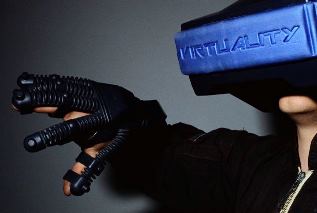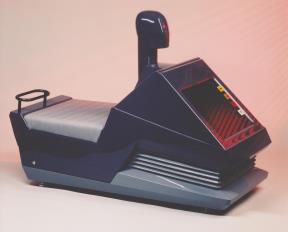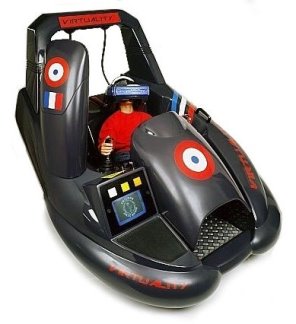A Report on the presentation by W.Industries.
© Chris Hand, 1991
INSIDE THE VIRTUALITY SYSTEM
The system comprises a User Interface (sensors, headset etc.), Host Computer, Software and Console.
User Interface

The key element of the user interface is the visor (or "visette"). This contains a sensor for 3-dimensional head tracking, along with the colour TFT LCD screens which create the stereo image. The inputs to the screens are simply RGB signals created by the graphics boards. The screens provide a resolution of 276 horizontal by 376 vertical pixels, with the graininess of the image created being removed using a "special convolver". The screens are actually mounted on the sides of the user's head, to avoid making the visor front-heavy (balancing of the unit being very important since it has to be able to be used in a Video Arcade environment: safety of users when moving the head quickly from side to side is paramount). This side-mounting technique means that the optical path has to be folded, with each image passing through a collimating lens and a mirror.
The headset also has a built-in microphone and quadraphonic sound with 2 speakers on each side of the head. The sound image in space is "vectored" by the host computer. A headband is provided which is adjustable to allow the user to fix the position of the unit relative to the top of the head, to create the stereo graphical image correctly. A clamp pulls down and fixes the unit on the head at the back: no chin-strap is used for safety. The visor can be quickly released in an emergency by simply tapping on the clamping bar.
This unit will, apparently, fit 90% of users. With the possibility of 200 people per day using the visor, hygiene is an important factor. Bacteria, fungus and livestock (eg. head lice) could all be a problem. The Glass-reinforced plastic headset unit is supplied with hygienic paper "wipes" which can be used to clean it between users. During health and safety testing, the headset unit had passed non- transmission tests with many bacteria and virii, including HIV. When not in use, the visor rests on a plastic "head" built onto the main unit.
Host Computer
Known as "Expality", this is a custom unit with a CD- ROM drive and floppy disk. Currently the CD-ROM contains only sound-effects and background scenes, while the floppy disks are used to transport the games software. The CD-ROM contains 5 games; a purchaser of the games unit must buy a separate key- disk for each program they wish to run. The computer -- actually an Amiga 3000 motherboard – handles tracking of sensors, sound and music (from samples). Rendering of graphical images is performed by two custom graphics boards (one per eye), using TMS 34020/082 at 40Mflops. Mr Rowley told us that the unit could render a maximum of 30,000 polygons/s, at 20 screen updates per second.
Console


This is simply a glass-reinforced plastic shell that protects the user and the electronics from each other. The driving game shell looks like a car (it has a lift-up lid like a car bonnet giving access to hardware). The stand-up unit has a cushioned "bench" (the electronics are underneath) on which one sits to strap on the visor/electronics. A small unit carrying cabling is tied round the waist and fits in the small of the back. The cables carry video and sensor signals to and from the headset.
Software
W Industries call their programs "virtual experiences". These are developed on desktop workstations using the same hardware as found in the Virtuality unit itself. The specification of each game is reviewed by "Games Consultants". The specification and creation of these experiences includes :
• Considering vehicle dynamics
• Network interaction (for team games)
• Creation of scenery and images (models are digitized with video cameras from many angles)
• The roles and behaviour of "Actors", which may be computer-generated or other players.
• The software must have start/finish sequences to instruct a (probably naive) user how to put on/take off headset etc.
Mr Rowley commented further on the developing VR market, suggesting that the stand-up units would be suitable for CAD as well as entertainment, although he doubted the present resolution would be adequate for virtual medical surgery. We were told that the stand-up units are being sold to those educational and research institutions that can afford the.
Furthermore, not much "real competition" exists in this area since, according to Mr Rowley, WI had the first real custom-made VR units on the market. Next we were shown a WI promotional video. Proclaiming "10 years of development towards Virtual Reality", the video featured clips of two women using sit-down units (with joy-sticks), followed by a demonstration of the stand-up units by two males. Other clips showed the data glove and "force feedback" glove being used for Desktop CAD (ie. non-immersed). Both these gloves can be worn on the same hand simultaneously.
After some more nebulous promises about the "possibilities of Virtual Reality", the video ended with the remark that W Industries' offering represented a "Production VR system at PC prices". In (non-virtual) reality, these prices turn out to be from GBP£ 17,500. A stand-up R&D system with full stereo and touch-glove would cost GBP £40,000. When the video had ended, questions were taken.


